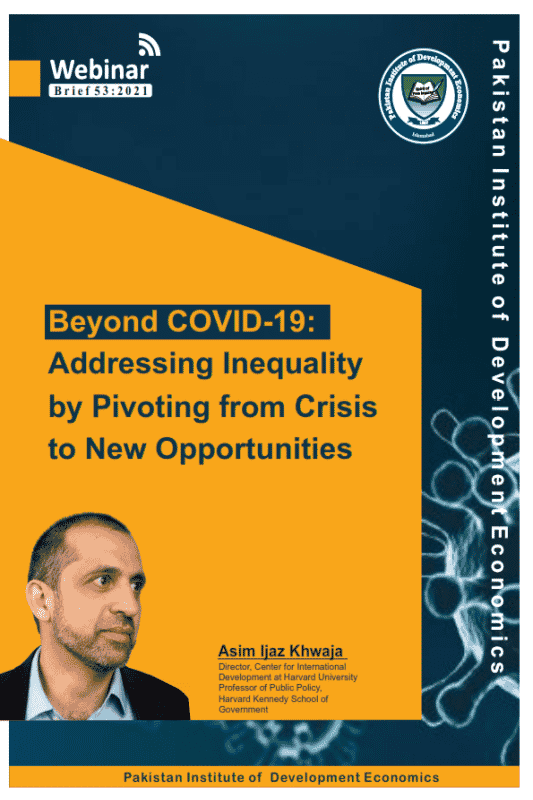
Pakistan Institute of Development Economics
- Home
Our Portals
MenuMenuMenuMenuMenuMenuMenu - ResearchMenuMenuMenuMenuMenuMenuMenu
- Discourse
- The PDR
- Our Researchers
- Academics
- Degree Verification
- Thesis Portal
- Our Portals
Beyond COVID-19: Addressing Inequality by Pivoting from Crisis to New Opportunities
Beyond COVID-19: Addressing Inequality by Pivoting from Crisis to New Opportunities
Preamble
The webinar has started with an interesting question: whether you like to be poor in a rich country or rich in a poor country. Everyone stated their own opinions such as one of the participants said being rich in a poor country, one has relatively better purchasing power while being poor in a rich country is a difficult life. On the contrary, one of the commentators believed that being poor in a rich country is comparatively better because the infrastructure of a rich country would be robust and the health care would be better even if you are poor. Another young man claimed that it is relative poverty that matters so it is preferable to be poor in a rich country because you would feel more secure in this way rather than being rich in a poor country would always be challenging in terms of being pointed out and rent-seeking.
You would be better off being poor in a rich country if you simply thought of welfare as income or even adjusting for the cost of living and for purchasing power parity. If we take a poor country like Nigeria as an example; Niger is the income share of the top 5 percent accounted for 21 percent with an adjusted purchasing power parity income of about 4,000 for someone who is in the top 5 percent of Niger. On the other hand, if you are in Norway, even if you are poor in the bottom 5 percent, you will still be earning about five times as much as you would if you were Niger. The difference between countries and within countries is enormous due to the stark difference between countries and income even the bottom of a rich country is substantially higher than the top of a poor country. Interestingly, this story is not true in the case of the USA, if we replace Norway with the USA, the bottom 5 percent in the USA are worse off than the top 5 percent in Nigeria. Hence, it depends on which country you are talking about, like Norway is a country where there is less inequality than the USA.
Global Inequality: Within Countries or Between the Countries?
Furthermore, if you look at this figure, it is just decomposing inequality between countries. Glaringly, Figure 1 is highlighting the importance of the between-country component; if you look at the early 1800s, most of the inequality was within countries while in the last couple of decades the trend has been the other way around and the inequality can be seen between the countries. Additionally, the next graph depicts the same thing in more continuous decomposition between country versus within-country inequality and the same pattern can be seen. However, an interesting thing is that in the former figure inequality between the countries was more apparent while this trend is commencing to change; so gradually we are beginning to add more within-country inequality.
Here is another way to decompose what is happening on inequality, when you think of inequality overall like the gini coefficient, you hide something very interesting which is happening. That hidden interesting fact is the inequality change that is really at play; if you think of income distribution that poor are getting poorer and rich is getting richer, that is not what is going on. To describe this, another graph (Figure 2) has been used where the y-axis is depicting the change over 1980 to 2016, while the x-axis is displaying the percentile of income. If you look at the x-axis of the graph, 10 means the bottom 10 percent, and 99.9 is the top point one percent. Moreover, if you pay heed to the 40 percentile and below, they have grown quite a lot; so this is the rise of the emerging economies. For most of the people who belong to the middle-income group from the US and Western Europe, look at the 50 percentile and above, we can observe less growth. The reason why you are seeing inequality in this graph is that all the action is coming at the very top (99.9 percentile); it means that this inequality issue in the world is mostly coming from this extremely affluent group. When you think of inequality, keep this fact in mind which is portrayed in the graph that the poor have done far better than the middle class and elite class.
Figure 1: Accounting for the Rise in Global Inequality
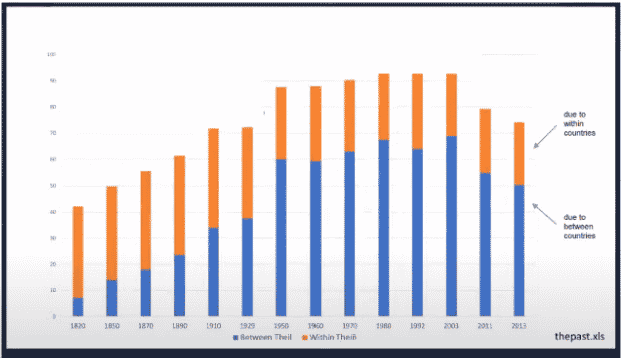
Figure 2: The Elephant Curve of Global Inequality & Growth, 1980-2016
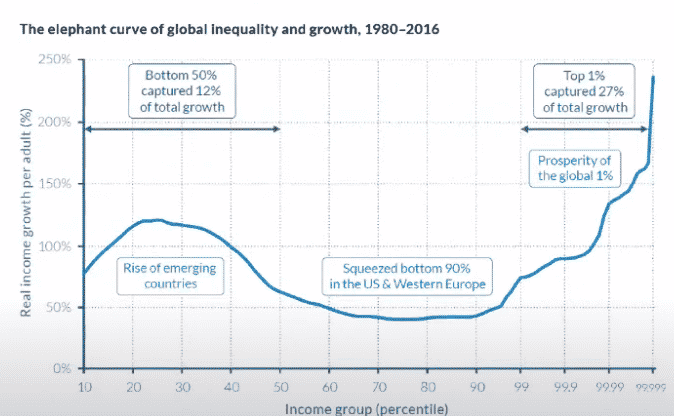
Inequalities in Context of COVID – 19
If we talk about it in the context of COVID-19, unfortunately, it has worsened the situation. There are some pictures (combined in Figure 3) of the recession that can be seen in which the quartiles of income are presented where the green line is showing the richest 25 percent while the purple line is for the bottom 25 percent. Now when you look at different years like 1990, 2001, or 2008 recessions, you can notice the poor (purple line) tend to be slightly worse than the rich (green line); it is not the case in 1990 though. Now pay attention to the COVID-19 crisis which is incredibly severe; unlike any other recessions, COVID-19 crises have hit the poor hard. Thus, whatever the situation of inequality was in the past has gotten much worse because of the COVID-19 pandemic. Another graph (Figure 4) can be seen comprising 150 years which is showing the share of all the countries in the crises. As we all know that besides the great depression, the COVID-19 crisis is also global. This is the time when the elite 1 percent owns about half of the world’s wealth. Interestingly enough this elite group ended up saving more wealth during this COVID-19 crisis and the decline in spending is driven by the same wealthy group. The reason behind this interesting fact is the canonical model; this model says the poor do not have enough to spend on luxuries rather they only spend on necessities such as food so their spending might not have dropped that much during the COVID-19 crisis. Hence, during this pandemic, not only is the income shock unequal but also the savings; you can see another graph (Figure 5) which is clearly showing that more savings are going on in the USA. It means that the elite already had most of the wealth in the world and now their net savings are also surging. If you think of recovery from this crisis, the poor have blown away their savings; their income fell yet they have to keep spending the same so their buffer has gone down.
Figure 3: The COVID – 19 Crises is Different
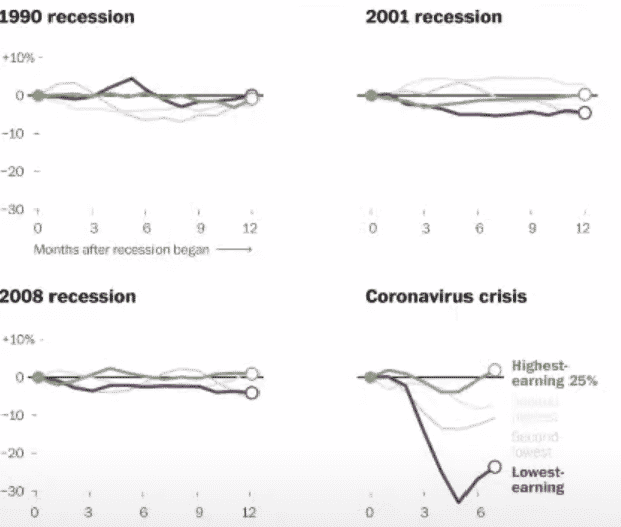
Figure 4: Economies with Contractions in Per Capita GDP
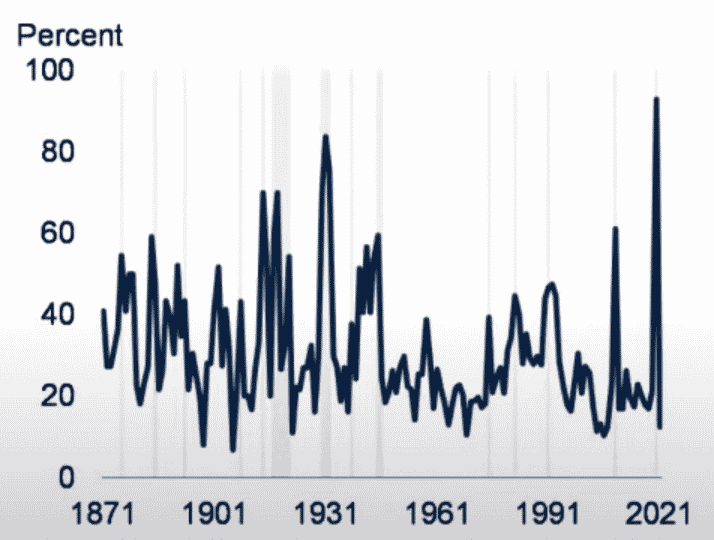
Figure 5:Savings
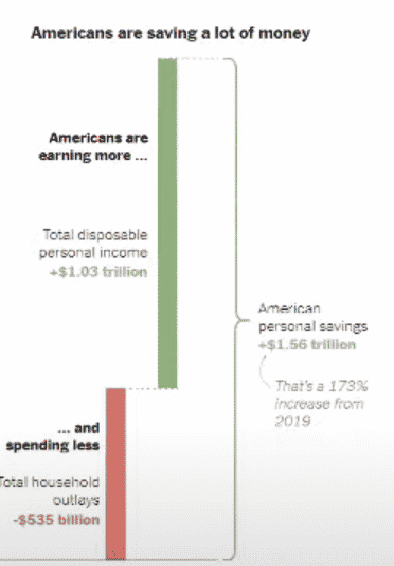
Is Reducing Poverty Enough? & What Should We Think Post COVID-19?
Now the real question is whether eradicating poverty is enough and it does not look like it, we need to do more. Another question is how we should think about addressing this exacerbating inequality as we already have started with a tough situation that has gotten even worse, so what would be our post-COVID strategies. The Center for International Development (CID) at Harvard advances the message that reducing poverty is not enough. We also need to create a world of givers by enhancing global talent everywhere. COVID-19 provides an opportunity to address the problem of inequalities.
Beyond the COVID-19: A Global Call to Action
COVID-19 is not only a health crisis; it is a development crisis.
¾ Health: longer-term health consequences (Child Immunization, mental health, chronic illness, etc.)
¾ Education: learning loss and unequal access.
¾ Social Protection: impact on poverty, vulnerability, resilience.
¾ Firms & Workers: Shut-downs, job losses, reorienting work.
¾ Macroeconomy: Balance of Payment issues, macro stability, fiscal space.
¾ State capacity and cohesion.
It not only hits the economies adversely but also provides a global opportunity.
Beyond COVID – 19 Collaboration
Center for International Development (CID) at Harvard is trying to do a global, multi-year, and cross-sectoral collaboration between academia, and public, private, and non-profit leaders to better respond to COVID-19 and help in rebuilding a thriving world.
¾ Comprehensive research and policy agenda
¾ Leverage talent at Harvard and in-country partners
¾ Collaborate & build capacity with selected policy ‘site partners’ (country & regional level)
Now the question is, how do we move on this? This is the first thing that we need to look at. COVID – 19 is not only a pandemic but also is an information failure in many ways. First and foremost, for an immediate policy response, we need to collect data rapidly.
- DATA ACQUISITION
Generate and facilitate rapid real-time flows of information on the impact of COVID and capture snapshots of the evolving health of different sectors.
- COVID Life Panel data collection
- Access and leverage existing datasets
- TECH
Build and deploy the talent of leaders and equip them with tools to design and implement effective policy.
- Blended learning training with site partners
- Student field engagements
- RESEARCH
Develop and cross-fertilize evidence on the impact of COVID and test innovations on informal global knowledge, policy-making, and implementation.
- Country–specific policy research engagements with country and region cite partners
- Incubation sessions along with support for travel, pilot, and full research projects
- CONVENE
Bring together leading Harvard researchers, high–level policymakers, and communities of practice to bridge the research and practice and to disseminate useful, timely, insights.
- Country and regional events & webinars
- Communities of practice
- Beyond COVID conference at Harvard
- Data visualization platform
To sum up, opportunities can be created through structural and governance changes. System-wise changes in the country are required. This state has to be set up in a way that can address inequalities. Post-COVID reforms should build a state which is the more effective state using technology.

